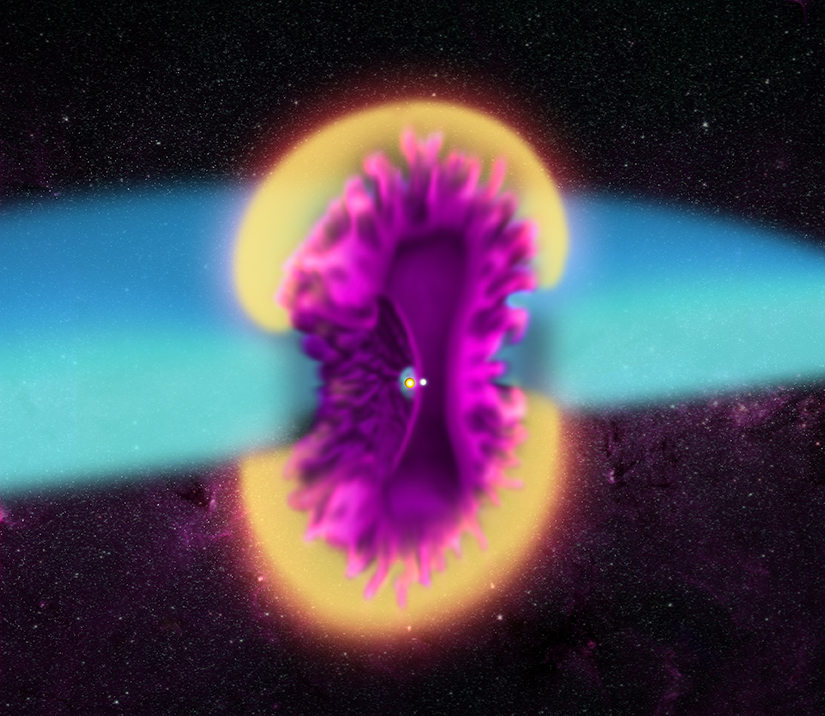
 Credit: 3D Model: INAF-Osservatorio Astro. di Palermo/S.Orlando
Credit: 3D Model: INAF-Osservatorio Astro. di Palermo/S.Orlando
Bipolar Blast in 3D
Nova explosions happen in binary star systems, in which one star is a mostly normal type of star, but the other has run out of fuel and is now as a superdense, burnt-out, earth-sized cinder of the star's core, a white dwarf. If the white dwarf and the normal companion star are close enough, the white dwarf can gravitationally pull matter from the companion. This stolen, hydrogen-rich material builds up on the surface of the white dwarf, which, if it becomes hot and dense enough, the hydrogen nuclei can suddenly fuse into helium, producing a thermonuclear flash that we can observe as a sudden brightening in the sky. An example of such an outbursting white-dwarf binary system is called V745 Sco Astronomers noticed a sudden brightening of this binary system in 2014, and, in the nine days before it faded, used powerful telescopes on earth and in space to monitor the outburst, including key observations in the X-ray band by the Chandra X-ray Observatory. The high-resolution Chandra observations showed that most of the hot material produced by the blast was moving towards us, unexpected if the blast wave was distribute evenly around the entire white dwarf. Analysis of the Chandra data and other observations allowed astronomers to produce a 3-D model of the outburst, shown in the image above. The sudden fusion of hydrogen on the surface of the white dwarf produces a blast wave, which is shown in yellow in the model image. The blast ejected about a tenth of an earth mass of material from the white dwarf, which is shown in purple. A thick disk of cooler material around the binary, shown in blue, helps channel the blast above and below the disk. The X-ray observations mean that one side of the disk is tilted towards us, so that we have a much better view of the material moving towards us compared to the material moving away. The data also suggest that, as the debris from the white dwarf strikes the companion and slows down, it produces a cavity around the two stars. If an accreting white dwarf gains enough material, the entire white dwarf will suddenly burst into a thermonuclear fireball, producing not a nova but a far more powerful supernova. These exploding white dwarf supernovae are very useful to astronomers for studies of the distant Universe, since they all have about the same brightness and can be viewed to enormous distances because they are so powerful. The analysis of V745 Sco shows that the amount of material ejected is less than the amount that produced the nova outburst, showing that there's a net gain of material in V745 Sco, pushing it a little closer to the day when it will explode as a supernova.
Published: August 23, 2021
<
HEA Dictionary ● Archive
● Search HEAPOW
● Other Languages
● HEAPOW on Facebook
● Download all Images
● Education ● HEAD
>

Each week the HEASARC
brings you new, exciting and beautiful images from X-ray and Gamma ray
astronomy. Check back each week and be sure to check out the HEAPOW archive!
Last modified Tuesday, 27-Feb-2024 10:10:19 EST


